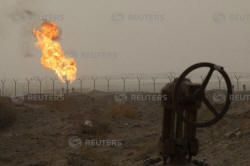|
Benchmark Brent crude <LCOc1> fell below $70 a barrel for the
first time since early April, down more than 18 percent since
reaching four-year highs at the beginning of October.
Brent dropped $1.52 to a low of $69.13 before recovering to
around $69.60 by 1135 GMT, down 4.5 percent for the week and
approaching 16 percent this quarter.
U.S. light crude <CLc1> fell to an eight-month low below $60 a
barrel, hitting a trough of $59.28, down $1.39 and off more than
20 percent since early October. That puts the U.S. contract
officially in "bear market" territory, borrowing a definition
commonly used in stock markets.
"There is no slowing down the bear train," said Stephen Brennock,
an analyst at London brokerage PVM Oil. "Instead, the energy
complex has extended a rout driven by swelling global supplies
and a softening demand outlook."
Oil peaked in October on concerns that U.S. sanctions on Iran
that came into force this week would deprive the oil market of
substantial volumes of crude, draining inventories and bringing
shortages in some regions.
But other big producers, such as Saudi Arabia, Russia and shale
companies in the United States, have increased output steadily,
more than compensating for lost Iranian barrels.
The United States, Russia and Saudi Arabia are pumping at or
near record highs, producing more than 33 million barrels per
day (bpd), a third of the world's oil.
The U.S. sanctions, meanwhile, are unlikely to cut supply as
much as expected. Washington has granted exemptions to Iran's
biggest buyers, allowing them to buy limited amounts of oil for
at least another six months.
China National Petroleum Corp said it was still taking oil from
Iranian fields in which it has stakes.
Washington has said it wants to force Iranian oil exports down
to zero, but Bernstein Energy now expects "Iranian exports will
average 1.4 million to 1.5 million bpd" during the exemption
period, about half the volume in mid-2018.
"As OPEC exports continue to rise, inventories continue to
build, which is putting downward pressure on oil prices,"
Bernstein said. "A slowdown in the global economy remains the
key downside risk to oil."
A glut in the refining sector, where a wave of unsold gasoline
has pulled profit margins into negative territory, may also lead
to a slowdown in new crude orders as refiners scale back
operations.
(Reporting by Christopher Johnson in London and Henning
Gloystein in Singapore; Editing by Dale Hudson and Emelia
Sithole-Matarise)
[© 2018 Thomson Reuters. All rights
reserved.] Copyright 2018 Reuters. All rights reserved. This material may not be published,
broadcast, rewritten or redistributed.
Thompson Reuters is solely responsible for this content.
 |
|




